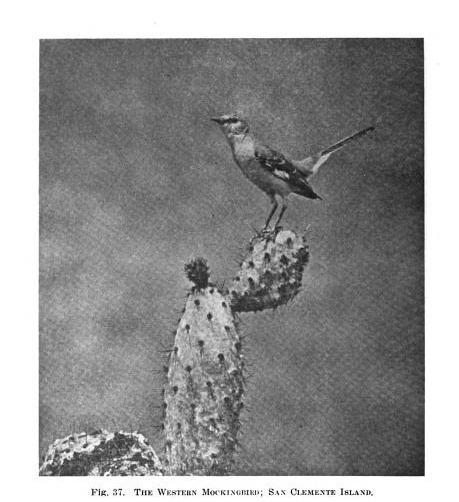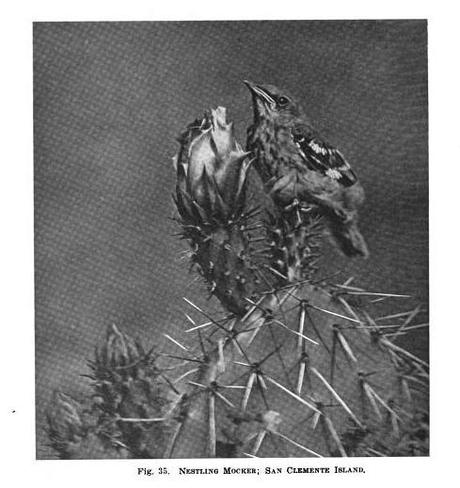
WESTERN MOCKINGBIRD: Mimus polyglottos leucopterus
- Family: The Wrens, Thrashers, etc .
- Length: 9.00" - 11.00"
- Adults: Upper parts, plain gray; wings and tail, blackish; wings with white patch at base of primaries; wing bars, white tipped; wing quills and tertials with whitish edgings; under parts, white tinged with grayish - more brownish in autumn.
- Young: Upper parts more brownish black, indistinctly streaked, or spotted with darker breast, spotted with dusky.
- Geographical Distribution: United States (rare north of latitude 38) from the Gulf of Mexico to the Pacific coast and in Lower California.
- California Breeding Range: Chiefly in the San Diegan district but also throughout the lower Sonoran zone to San Joaquin Valley.
- Breeding Season: April, May, and June
- Nest: Of small twigs and weeds lined with finer material, and sometimes horsehair and cotton; placed from 6 inches to 50 feet high in thick bushes, hedges, vines, and trees.
- Eggs: 4 or 5 pale bluish or greenish, spotted with reddish brown.
- Size: 0.94 X 0.71
The Western Mockingbird is to Southern California what the American robin is to the Eastern States - the friendly dweller near the homes of men. From the fruit trees in the orchard, from the shrubs on the lawn, from the tops of the house chimneys, he pours such a flood of delirious music that the woods and the streams stand silent to listen.
No bird has been oftener written about. It would be difficult to say anything original concerning him, but Mrs Bailey's inimitable description is worth quoting;
The Mocker almost sings with his wings. He has a pretty trick of lifting them as his song waxes, a gesture that not only serves to show off the white wing patches, but gives a charming touch of vivacity, an airy, almost sublimated fervor to his love song. His fine frenzies often carry him quite off his feet. From his chimney-top perch, he tosses himself up in the air, and dances and pirouettes as he sings, till he drops back, it would seem, from sheer lack of breath. He sings all day and often, if we would believe his audiences ,he sings down the chimney all night, and when camping in Mockerland, in the full of the moon, you can almost credit the contention. A Mocker in one tree pipes up and that wakes his brother Mockers in other trees, and when they have all done their parts, every other sleepy little songster in the neighborhood - be he sparrow or wren - rouses enough to give a line of his song.
His nest, placed often in the hedgerows bordering the lawn, is presided over by his more quiet mate who broods for fourteen days on the mottled blue eggs. There is no need to peek into the nest to ascertain whether those eggs have hatched, for his fussiness proclaims the event to all who care to know. And now come busy days

Both male and female Mockers flit through the green like silent shadow,s hunting insects under the leaves, earthworms on the ground, or berries in the garden. These are all swallowed first and delivered to the infant Mockers by regurgitation for the first few days, or until the babies' eyes open. After that, the number of earthworms, butterflies, etc, devoured by those nestlings rivals the story of the young robins who, in twelve hours, ate forty per cent more than their own weight.
There seems to be no limit to their appetite, and scarcely any to their capacity. Even after they leave the nest and are nearly as large as the adults, they follow the overworked father about, begging with quivering wings. They are remarkably handsome youngsters with their soft brownish coats and spotted breasts, well deserving the care and pride their fond parents bestow upon them.
~Irene Grosvenor Wheelock, Birds of California, 1903
